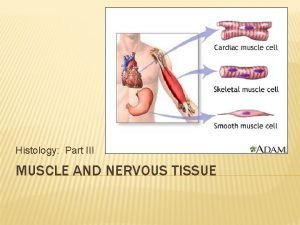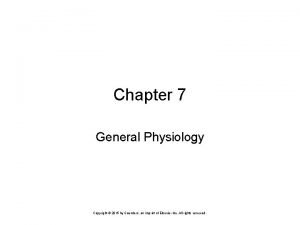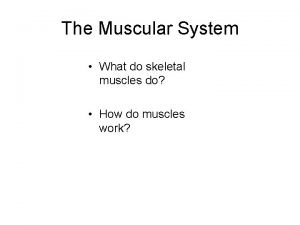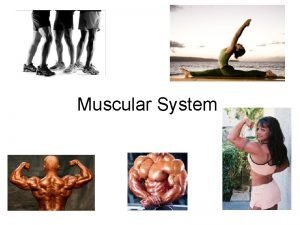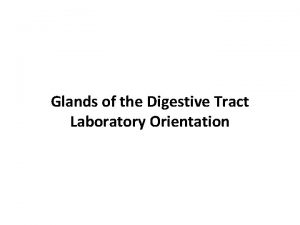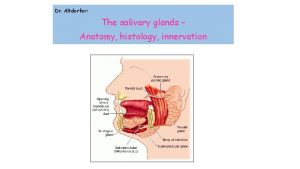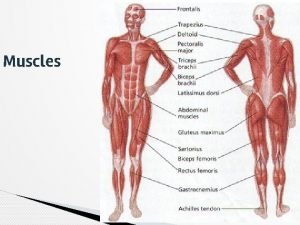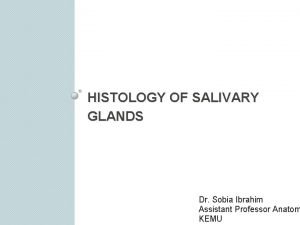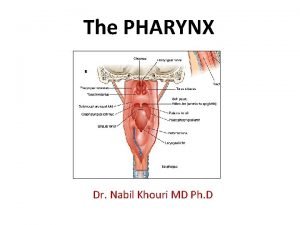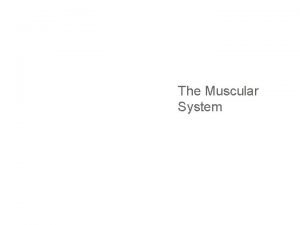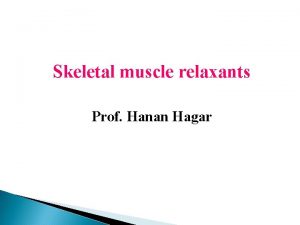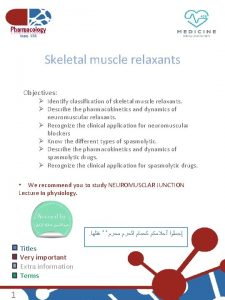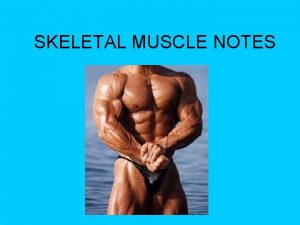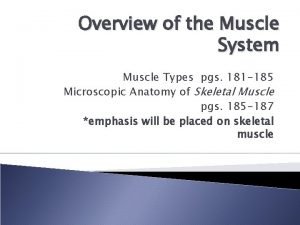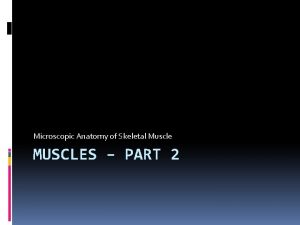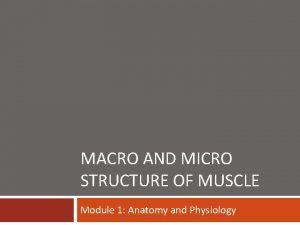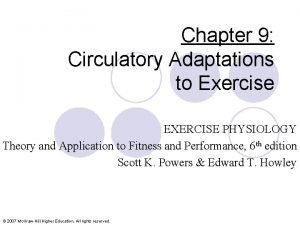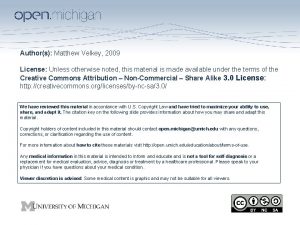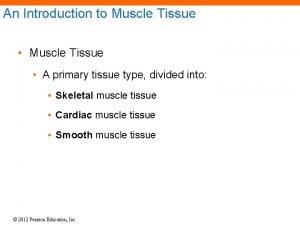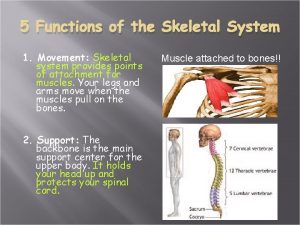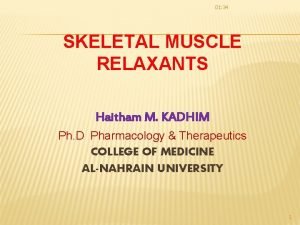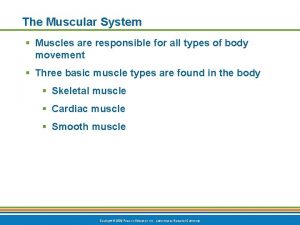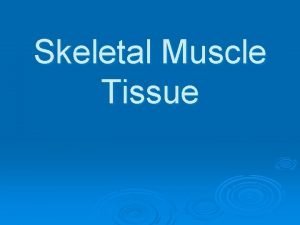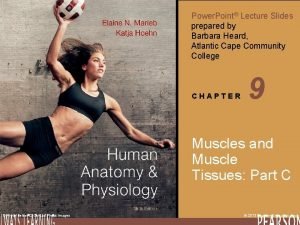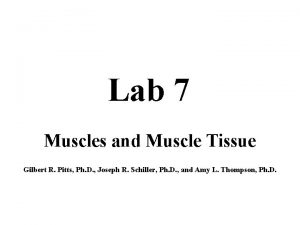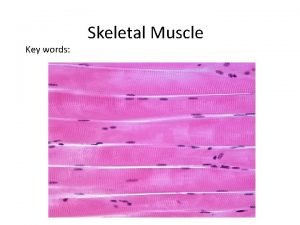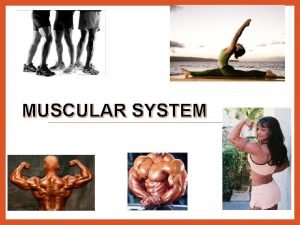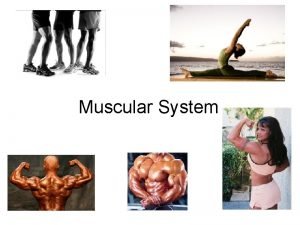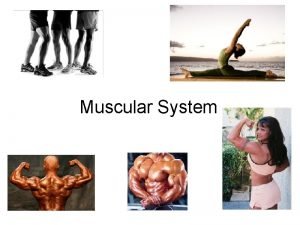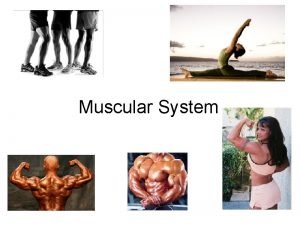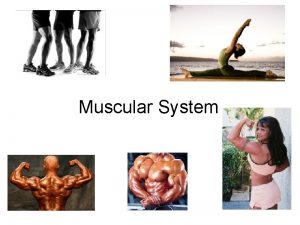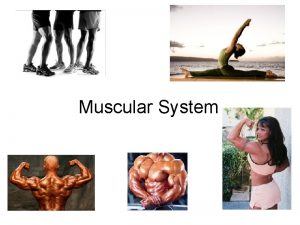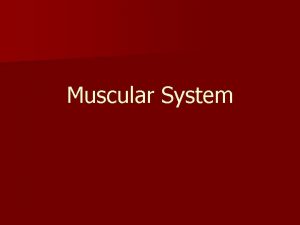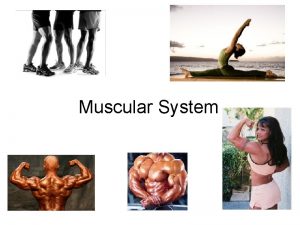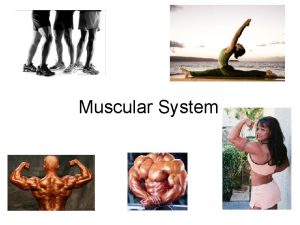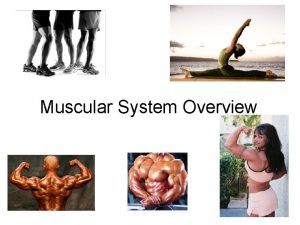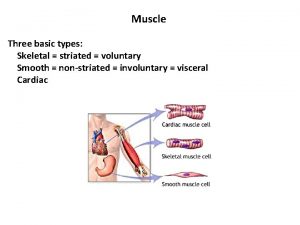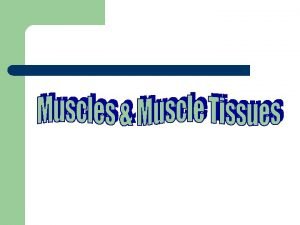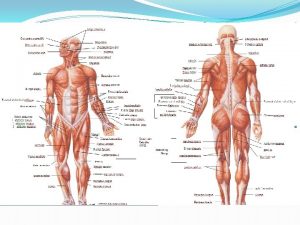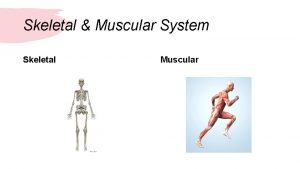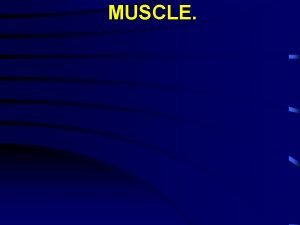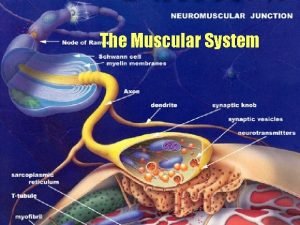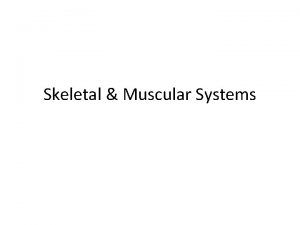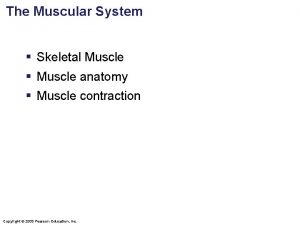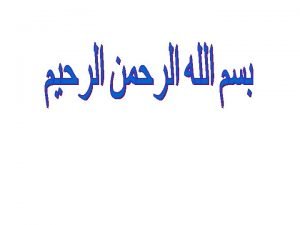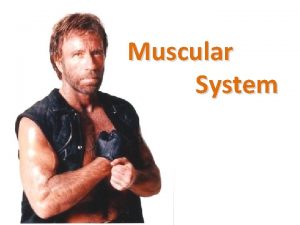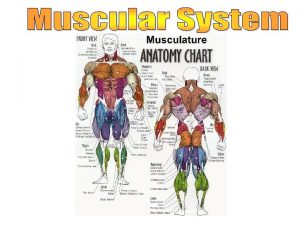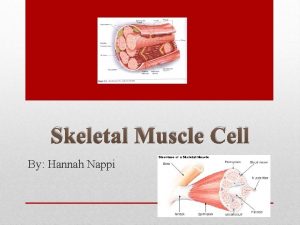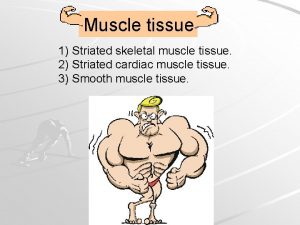Muscular System Types of Muscle Skeletal striated voluntary










































- Slides: 42

Muscular System

Types of Muscle • Skeletal – striated & voluntary • Smooth – involuntary • Cardiac - heart


Muscles and Muscle Fibers Muscles are composed of many fibers that are arranged in bundles called FASCICLES Individual muscles are separated by FASCIA, which also forms tendons and aponeuroses


SARCOLEMMA Sarcolemma = muscle fiber membrane Sarcoplasm = inner material surrounding fibers (like cytoplasm) Myofibrils = individual muscle fibers -- > made of myofilaments

Myofibril Contains protein filaments – ACTIN (thin) and MYOSIN (thick) These filaments overlap to form dark and light bands on the muscle fiber §A band = d. Ark • thick (myosin) §I band = l. Ight • th. In (actin) • In the middle of each I band are Z lines. • A sarcomere is the space between one Z line and the other

A Portrait of a Myofibril


It is important to remember the heirarchy myosin myofibrils fasicles myofilaments actin

It is important to remember the heirarchy fasicles myofibrils myofilaments actin myosin

muscle fiber myofilament epimysium muscle myofibrils sarcomere

myofilament muscle sarcomere epimysium myofibrils muscle fiber

Terms to know… • • • 1. Threshold Stimulus 2. All-or-None Response 3. Motor Unit 5. Recruitment 6. Muscle Tone 7. Muscular Hypertrophy 8. Muscular Atrophy 9. Muscle Fatigue 10. Muscle Cramp 11. Oxygen Debt

Threshold Stimulus Minimal strength required to cause a contraction Motor neuron releases enough acetylcholine to reach threshold All-or-None Response Fibers do not contract partially, they either do or don't

Motor Unit The muscle fiber + the motor neuron Recruitment more and more fibers contract as the intensity of the stimulus increases Muscle Tone Sustained contraction of individual fibers, even when muscle is at rest

Hypertrophy - muscles enlarge (working out or certain disorders) Atrophy - muscles become small and weak due to disuse

Muscle Fatigue - muscle loses ability to contract after prolonged exercise or strain Muscle Cramp - a sustained involuntary contraction Oxygen Debt - oxygen is used to create ATP, during exercise you may not have enough oxygen -> this causes Lactic Acid to accumulate in the muscles

Origin and Insertion Origin = the immovable end of the muscle Insertion = the movable end of the muscle **when a muscle contracts the insertion is moved toward the origin The biceps brachii has two origins (or two heads).

How Muscles Work…

Muscle Contraction • Six key components – – – Myosin Actin Tropomyosin Troponin ATP Calcium ions • The theory of how muscle contracts is the sliding filament theory. The contraction of a muscle occurs as the thin filament slide past the thick filaments.

Muscle Contraction – Step 1 • The sequence of events leading to contraction is initiated somewhere in the central nervous system, either as voluntary activity from the brain or as reflex activity from the spinal cord.

Muscle Contraction – Step 2 • A motor neuron in the ventral horn of the spinal cord is activated, and an action potential passes outward in a ventral root of the spinal cord.

Muscle Contraction – Step 3 • The axon branches to supply a number of muscle fibers called a motor unit, and the action potential is conveyed to a motor end plate on each muscle fiber.

Muscle Contraction – Step 4 • At the motor end plate, the action potential causes the release of packets of acetylcholine into the synaptic clefts on the surface of the muscle fiber.

Muscle Contraction – Step 5 • Acetylcholine causes the electrical resting potential under the motor end plate to change, and this then initiates an action potential which passes in both directions along the surface of the muscle fiber.

Muscle Contraction – Step 6 • At the opening of each transverse tubule onto the muscle fiber surface, the action potential spreads inside the muscle fiber.

Muscle Contraction – Step 7 • At each point where a transverse tubule touches part of the sarcoplasmic reticulum, it causes the sarcoplasmic reticulum to release Ca++ ions.

Muscle Contraction – Step 8 • The calcium ions result in movement of troponin and tropomyosin on their thin filaments, and this enables the myosin molecule heads to “grab and swivel” their way along the thin filament. • This is the driving force of muscle contraction.

Muscle Contraction – Step 9 • Acetylcholine at the neuromuscular junction is broken down by acetylcholinesterase, and this terminates the stream of action potentials along the muscle fiber surface.

Muscle Contraction – Step 10 • The sarcoplasmic reticulum ceases to release calcium ions, and immediately starts to resequester all the calcium ions that have been released.

Muscle Contraction – Step 11 • In the absence of calcium ions, a change in the configuration of troponin and tropomyosin then blocks the action of the myosin molecule heads, and contraction ceases.

Muscle Contraction – Step 12 • In the living animal, an external stretching force, such as gravity or an antagonistic muscle, pulls the muscle back to its original length.

Sliding Filament Handout

Action Potentials Initiate Muscle Contractions

How Sliding Filaments Cause Muscle Contraction

Energy Source for Muscle Contractions • Provided by ATP from cellular respiration (mitochondria) • Creatine phosphate increases regeneration of ATP • Much of the energy forms heat, which keeps our bodies warm

ENERGY Fibers contain multiple mitochondria for energy Mitochondria break down glucose to make ATP (energy) through glycolysis Most fibers have multiple nuclei


What is rigor mortis? A few hours after a person or animal dies, the joints of the body stiffen and become locked in place. This stiffening is called rigor mortis. Depending on temperature and other conditions, rigor mortis lasts approximately 72 hours. The phenomenon is caused by the skeletal muscles partially contracting. The muscles are unable to relax, so the joints become fixed in place.

What is tetanus? Tetanus causes cholinosterase to not break down the acetylcholine in the synapse. This results in a person's muscles contracting and not relaxing. A tetanus shot must be administered shortly after exposure to the bacteria. Once you develop tetanus, there is no cure.

And now…a little video for your viewing pleasure…
 Which type of muscle is non-striated and involuntary
Which type of muscle is non-striated and involuntary Muscle
Muscle Which muscle is striated in appearance but resembles smooth
Which muscle is striated in appearance but resembles smooth Fusiform muscle
Fusiform muscle Major skeletal muscles
Major skeletal muscles Skeletal and muscular system
Skeletal and muscular system Perfect and imperfect voluntariness examples
Perfect and imperfect voluntariness examples Somatic motor neuron
Somatic motor neuron Tecido muscular
Tecido muscular Striated duct
Striated duct Webers gland
Webers gland Striated triceps
Striated triceps Tubuloacinar
Tubuloacinar Chapter 36 skeletal muscular and integumentary systems
Chapter 36 skeletal muscular and integumentary systems Chapter 14 skeletal muscular and nervous systems
Chapter 14 skeletal muscular and nervous systems Difference between strength and endurance
Difference between strength and endurance Pharyngeal tubercle
Pharyngeal tubercle Golden rules of skeletal muscle activity
Golden rules of skeletal muscle activity Centrally acting skeletal muscle relaxants
Centrally acting skeletal muscle relaxants Skeletal muscle relaxants classification
Skeletal muscle relaxants classification Peripherally acting muscle relaxant
Peripherally acting muscle relaxant Muscle relaxant classification
Muscle relaxant classification Epi peri endo
Epi peri endo Comparison of skeletal cardiac and smooth muscle
Comparison of skeletal cardiac and smooth muscle Skeletal muscle relaxants classification
Skeletal muscle relaxants classification Cardiac skeletal and smooth muscle comparison
Cardiac skeletal and smooth muscle comparison Microscopic anatomy of skeletal muscle
Microscopic anatomy of skeletal muscle Macro and micro structure of the skeletal muscle
Macro and micro structure of the skeletal muscle Muscle fiber organization
Muscle fiber organization Skeletal muscle pump
Skeletal muscle pump Cardiac muscle cross section
Cardiac muscle cross section Titin
Titin 5 functions of a skeleton
5 functions of a skeleton Skeletal muscle relaxants classification
Skeletal muscle relaxants classification Microscopic anatomy of skeletal muscle figure 6-2
Microscopic anatomy of skeletal muscle figure 6-2 Chapter 6 the muscular system figure 6-9
Chapter 6 the muscular system figure 6-9 Skeletal muscle nerve supply
Skeletal muscle nerve supply Myofiber vs myofibril
Myofiber vs myofibril Comparison of skeletal cardiac and smooth muscle
Comparison of skeletal cardiac and smooth muscle Label the superficial muscles
Label the superficial muscles Skeletal muscle cylindrical
Skeletal muscle cylindrical Skeletal muscle
Skeletal muscle Comparison of skeletal cardiac and smooth muscle
Comparison of skeletal cardiac and smooth muscle

